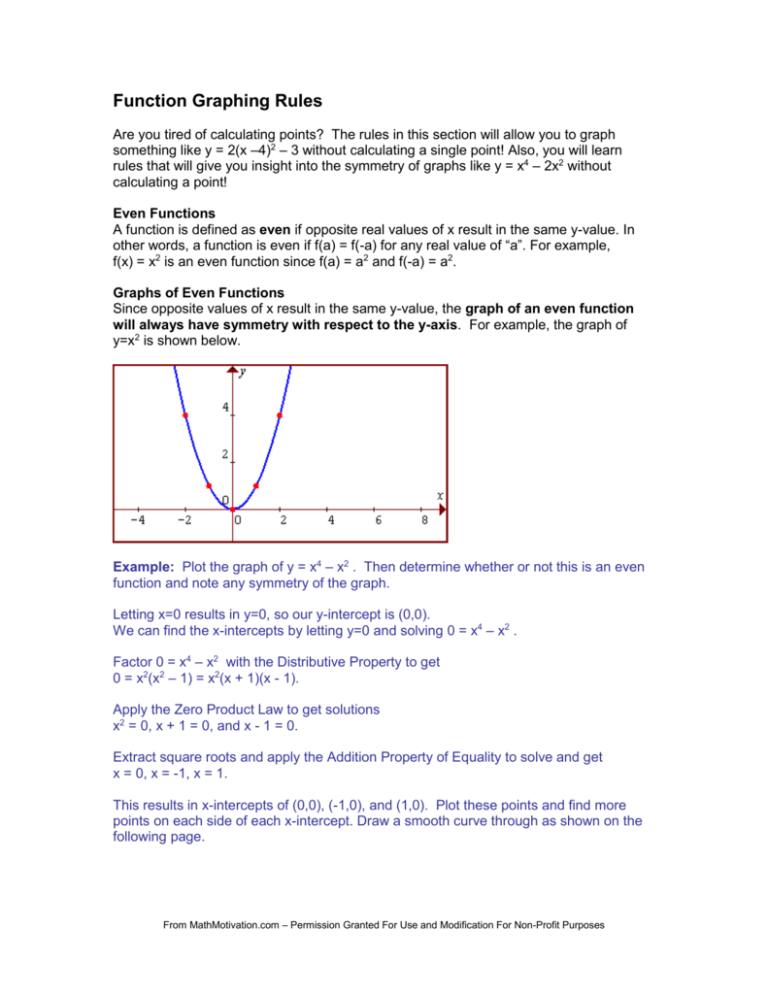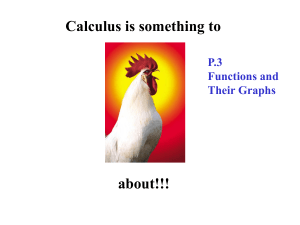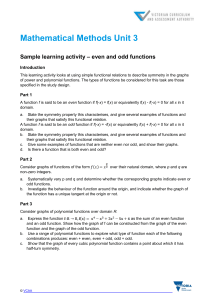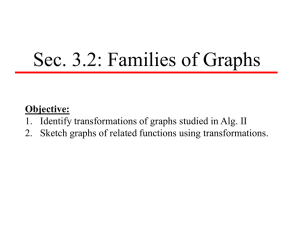Function Graphing Rules
advertisement

Function Graphing Rules Are you tired of calculating points? The rules in this section will allow you to graph something like y = 2(x –4)2 – 3 without calculating a single point! Also, you will learn rules that will give you insight into the symmetry of graphs like y = x4 – 2x2 without calculating a point! Even Functions A function is defined as even if opposite real values of x result in the same y-value. In other words, a function is even if f(a) = f(-a) for any real value of “a”. For example, f(x) = x2 is an even function since f(a) = a2 and f(-a) = a2. Graphs of Even Functions Since opposite values of x result in the same y-value, the graph of an even function will always have symmetry with respect to the y-axis. For example, the graph of y=x2 is shown below. Example: Plot the graph of y = x4 – x2 . Then determine whether or not this is an even function and note any symmetry of the graph. Letting x=0 results in y=0, so our y-intercept is (0,0). We can find the x-intercepts by letting y=0 and solving 0 = x4 – x2 . Factor 0 = x4 – x2 with the Distributive Property to get 0 = x2(x2 – 1) = x2(x + 1)(x - 1). Apply the Zero Product Law to get solutions x2 = 0, x + 1 = 0, and x - 1 = 0. Extract square roots and apply the Addition Property of Equality to solve and get x = 0, x = -1, x = 1. This results in x-intercepts of (0,0), (-1,0), and (1,0). Plot these points and find more points on each side of each x-intercept. Draw a smooth curve through as shown on the following page. From MathMotivation.com – Permission Granted For Use and Modification For Non-Profit Purposes It becomes clear that this is an even function as x=2 and x=-2 both resulted in y=12 and both x=1/2 and x=-1/2 both resulted in y = -3/16. Also, both terms of y = x4 – x2 involve even powers of x, making opposite input values of x result in the same yvalue. The graph of this function clearly exhibits symmetry with respect to the y-axis. TIP: Use the knowledge of even functions to give you a mental picture of the graph before you even plot it. By noting that y = x4 – x2 is even due to its even powers of x, we would know that its graph will be a mirror image of itself about the y-axis. Odd Functions A function is defined as odd if opposite real values of x result in opposite y-values. In other words, a function is odd if f(a) = -f(-a) for any real value of “a”. For example, f(x) = x3 is an odd function since f(a) = a3 and f(-a) = (-a)3 = -a3. Graphs of Odd Functions Since opposite values of x result in the opposite y-value, the graph of an odd function will always have symmetry with respect to the origin. This means that a 180 degree rotation of the graph (upside-down) results in the same graph. For example, the graph of the odd function y=x3 is shown below. Here, opposite values of x, like 2 and –2, resulted in opposite values of y, 8 and -8. The function consisting of this single odd power of x will always result in opposite y-values when opposite x-values are input. The graph has symmetry with respect to the origin since spinning it around 180 degrees about the origin results in the same graph. From MathMotivation.com – Permission Granted For Use and Modification For Non-Profit Purposes Example: Is the function f(x) = x3 – 1 odd? An easy way to show that a function is not odd is to input two opposite x-values. In this case, if we input x=2, we get f(2) = 8 – 1 = 7 and if we input x=-2, we get –8 – 1 = -9. Since 7 and –9 are not exact opposites, this function is not odd. It’s graph is shown below. If you spin the graph about the origin 180 degrees, you do not get the same graph. Shifting Functions Right If f(x) is a function, we can say that g(x) = f(x-c) will have the same general shape as f(x) but will be shifted to the right “c” units. This is shown below in the comparison of the graphs of y=x2 and y = (x – 4)2. The graph of y = (x – 4)2 has the same shape as y = x2 but is shifted 4 units to the right. RULE OF THUMB: If you replace each x in the formula with (x - c), your graph will be shifted to the right “c” units. From MathMotivation.com – Permission Granted For Use and Modification For Non-Profit Purposes Shifting Functions Left If f(x) is a function, we can say that g(x) = f(x+c) will have the same general shape as f(x) but will be shifted to the left “c” units. This is shown below in the comparison of the graphs of y=x2 and y = (x + 3)2. The graph of y = (x + 3)2 has the same shape as y = x2 but is shifted 3 units to the left. RULE OF THUMB: If you replace each x in the formula with (x + c), your graph will be shifted to the left “c” units. Shifting Functions Up If f(x) is a function, we can say that g(x) = f(x) + c will have the same general shape as f(x) but will be shifted up “c” units. This is shown below in the comparison of the graphs of y=x2 and y = x2 + 2. The graph of y = x2 + 2 has the same shape as y = x2 but is shifted 2 units up. RULE OF THUMB: If you add a positive value “c” to the formula, your graph will be shifted up “c” units. From MathMotivation.com – Permission Granted For Use and Modification For Non-Profit Purposes Shifting Functions Down If f(x) is a function, we can say that g(x) = f(x) -c will have the same general shape as f(x) but will be shifted down “c” units. This is shown below in the comparison of the graphs of y=x2 and y = x2 - 4. The graph of y = x2 - 4 has the same shape as y = x2 but is shifted 4 units down. RULE OF THUMB: If you subtract a positive value “c” from the formula, your graph will be shifted down “c” units. Reflecting Functions Across The x-axis If f(x) is a function, we can say that g(x) = -f(x) will have the same general shape as f(x) but will be reflected across the x-axis. This is shown below in the comparison of the graphs of y=x2 + 1 and y = -(x2 + 1). The graph of y = -(x2 + 1) has the same shape as y = x2 + 1 but is reflected across the x-axis. RULE OF THUMB: If you take the negative of the entire formula, your graph will be “flipped” across the x-axis. From MathMotivation.com – Permission Granted For Use and Modification For Non-Profit Purposes Reflecting Functions Across The y-axis If f(x) is a function, we can say that g(x) = f(-x) will have the same general shape as f(x) but will be reflected across the y-axis. This is shown below in the comparison of the graphs of y = (x + 1) and y = (-x + 1). RULE OF THUMB: If you replace each x in the formula with –x, the graph will be “flipped” across the y-axis. Vertically Stretching and Shrinking a Function If f(x) is a function, we can say that g(x) = cf(x) will have the same general shape as f(x) but will be vertically stretched or vertically shrunk by a factor of c. This is shown below in the comparison of the graphs of y=x2 , y = 2x2, and y = 0.5x2 The graph of y = 2x2 is vertically stretched by a factor of 2 and the graph of y=0.5x2 is vertically shrunk by a factor of 0.5 . RULE OF THUMB: If you multiply the entire formula by a constant, your graph will be vertically stretched out or shrunk, depending on the value of the constant. From MathMotivation.com – Permission Granted For Use and Modification For Non-Profit Purposes Using More Than One Function Shift Rule At a Time Often, you will use 2 or more of the function shift rules to predict what a graph will look like and where it will be located. For example, the graph of y = (x-2)2 + 1 is a shift of y=x2 right 2 and up 1 as shown below . Example: Use function shift rules to predict what the graph of y = -2(x + 1)2 – 3 will look like. We start with the function y = x2. y = (x + 1)2 will be a shift of y=x2 left 1. y = 2(x + 1)2 will be a vertical stretch of y = (x + 1)2 by a factor of 2. y = -2(x + 1)2 will be a reflection of f y = 2(x + 1)2 across the x-axis. y = -2(x + 1)2 –3 will be a shift of y = -2(x + 1)2 down 3 units. So in summary, shift left, vertically stretch, reflect, and shift down. The graphs you get through all these steps are shown below: TIP: Always do the vertical shift last. By the order of operations, the addition and subtraction operations associated with a vertical shift is done after the other operations. From MathMotivation.com – Permission Granted For Use and Modification For Non-Profit Purposes








